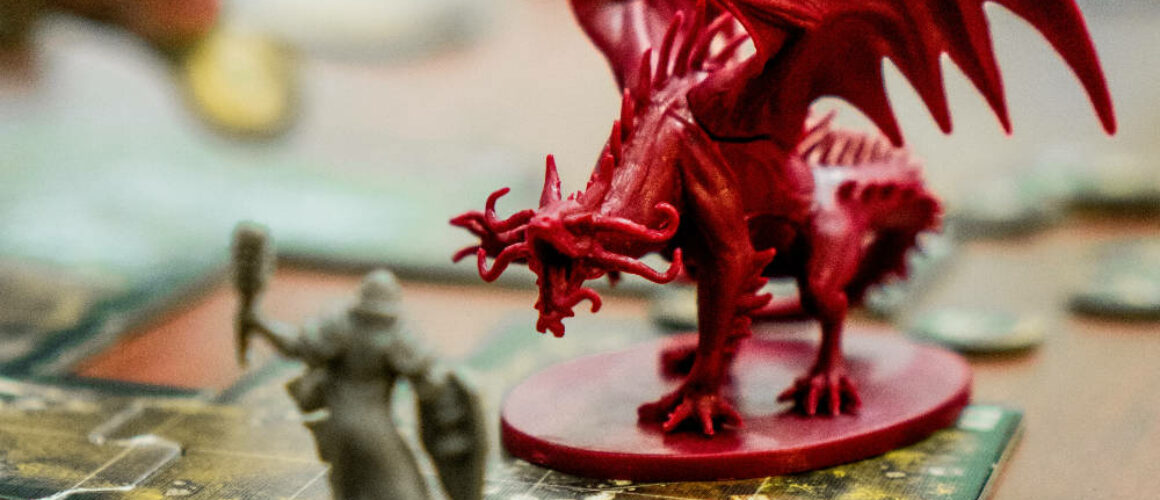The Dungeon Generator
In this tutorial, we will show you how to use the Dungeon Generator. This is the main tool we use to create dungeons during solo play. All the tables in this guide are all included in the Solo Gaming Tool which is available for free. There are three main oracles we use to create our dungeons: Room Tiles, Dungeon/Wilderness Content, and Battlemap Features. These three oracles together create indoor and wilderness battlemaps for our games.
What you will need
To use the Dungeon Generator you will need a pack of playing cards, a d100, and the oracles in this guide. You can use this Dungeon Generator with miniatures, terrain features, tokens, and graph paper. Graph paper is an affordable alternative to miniatures and works especially well with theatre of the mind.
Here’s a list of things you need:
- Pack of playing cards
- d100 dice
- The Solo Gaming Tool
- Dungeon/Wilderness Worksheet
Planning your dungeon exploration
Download the following Dungeon/Wilderness Worksheet and fill in the Description, Objective, and the Rank of the dungeon.
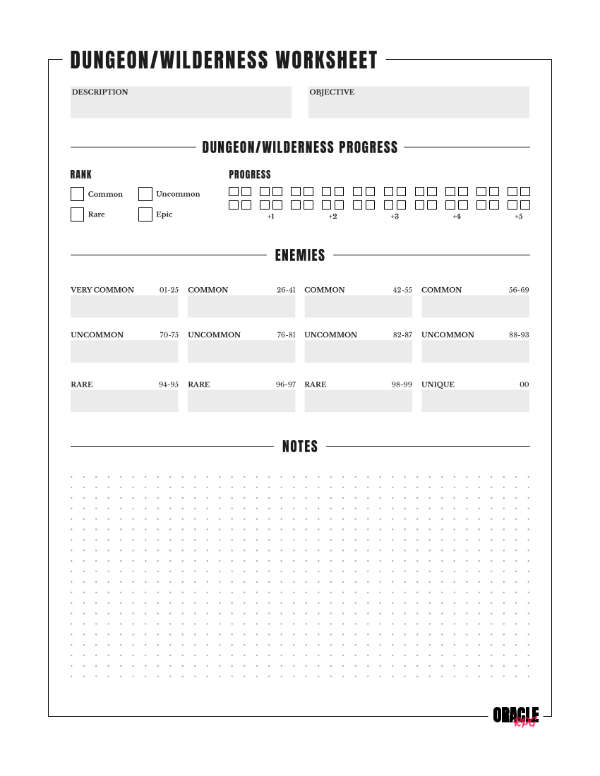
The Description describes the dungeon and how it fits into your adventure. Are you exploring an abandoned stronghold, a cave, or a haunted barrow? The Objective states what you’re doing in the dungeon. Are you looking for treasure or are you trying to kill a villain? Write down what you want to accomplish and write it in the Objective section of the Dungeon/Wilderness Worksheet.
The Rank of the dungeon determines how large, and dangerous the dungeon is. There are four ranks, Common, Uncommon, Rare, and Epic. A Common dungeon requires little time to explore and active traps have a lower trigger chance. An Epic dungeon requires a lot of exploration, and traps are more likely to trigger. To determine the Rank of your dungeon roll a 1d4; “1” is Common, “2” is Uncommon, “3” is Rare, and “4” is an Epic dungeon.
Enemies in your dungeon
There are tables online that give random encounters and they work fine in many cases. However, if you want your dungeon to have the monsters of your choice, fill in the Enemies table on the Dungeon/Wilderness Worksheet.
Consult the Monster Manual or any other suitable bestiary. Look at which enemies would make the most sense in your dungeon. Decide which ones look interesting and are within your capabilities to kill and place them on the Enemies table. Arrange your list of enemies according to how common or rare they are in your dungeon.
How to explore a dungeon with the Dungeon generator
Step 1: Determine the room tile
Shuffle a pack of playing cards, draw one card and consult Oracle 10: Room Tiles below.
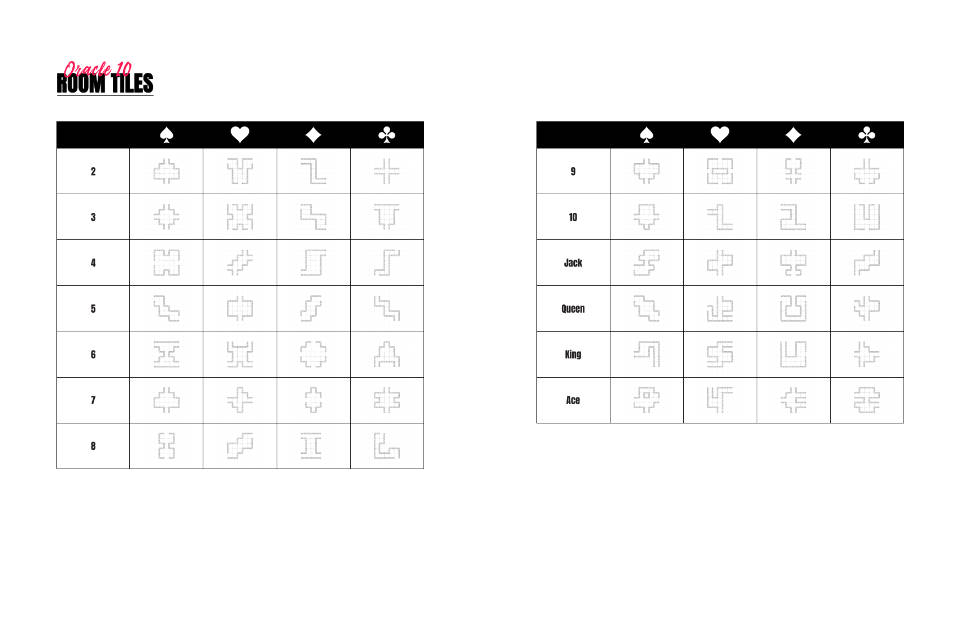
This will give you your first starting area. Place physical tiles or draw the room on graph paper according to the room tile on the oracle.
Step 2: Determine the room content
Place your character in the room and move them according to the movement rules of D&D. In 5e this is on page 190 of the Player’s Handbook. The openings in the tiles represent doors. When you reach a door roll a d100 and consult Oracle 11: Dungeon and Wilderness Content. This will tell you what’s inside the room.
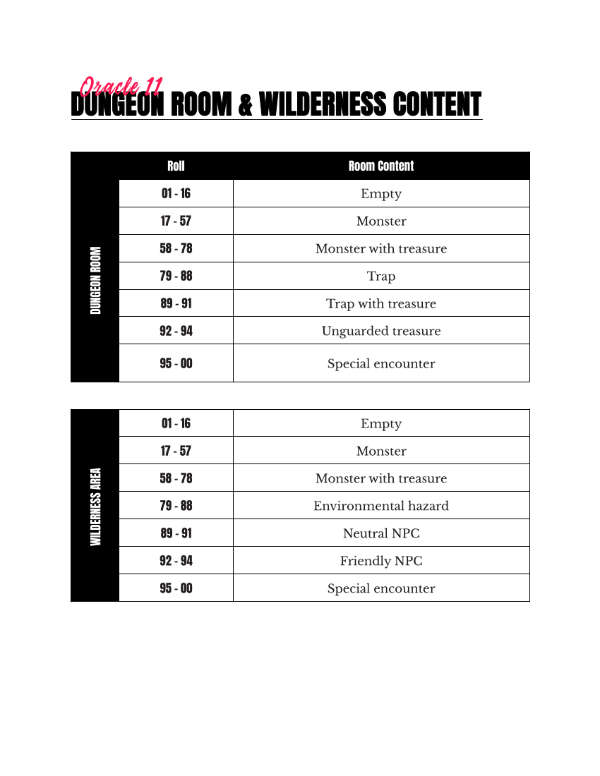
Step 3: Attack or evade enemies
Whenever you encounter a monster roll a d100 and consult the Enemies section on the Dungeon/Wilderness Worksheet you filled in earlier.
There are primarily two types of enemies in Oracle 11: monsters without treasure and monsters with treasure. Monsters without treasure don’t carry anything of use and have no loot. Monsters with treasure carry loot and you can use loot tables for them. This site has extensive tables for the individual treasure monsters can carry according to their Challenge Rating.
Step 4: Place terrain features
The Dungeon Generator uses terrain feature placement to quickly create a battlefield. If there’s going to be combat, roll a d100 and consult Oracle 12: Battlemap Features. This will provide you with the terrain features for your battlemap. Place these on your battlemap or draw them on graph paper. Place your party in the room and place the enemies on the opposite side of the room.
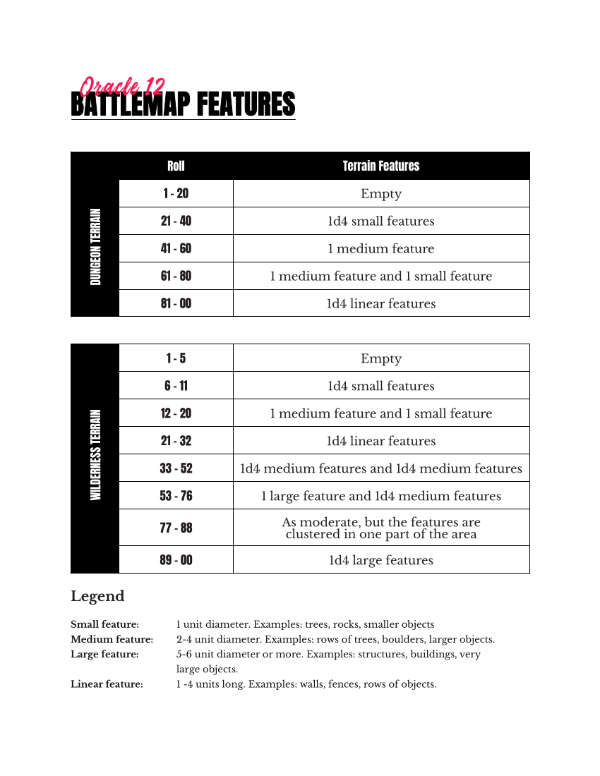
Step 5: Detect/disable traps
Traps are an important part of the Dungeon Generator. If there are any traps, detect or disable them. Until you disable or detect the trap, there is a chance it can trigger whenever a party member moves inside the room. To find out what kind of trap is in the room, roll a d100 and consult Oracle 13: Trap Descriptions below.
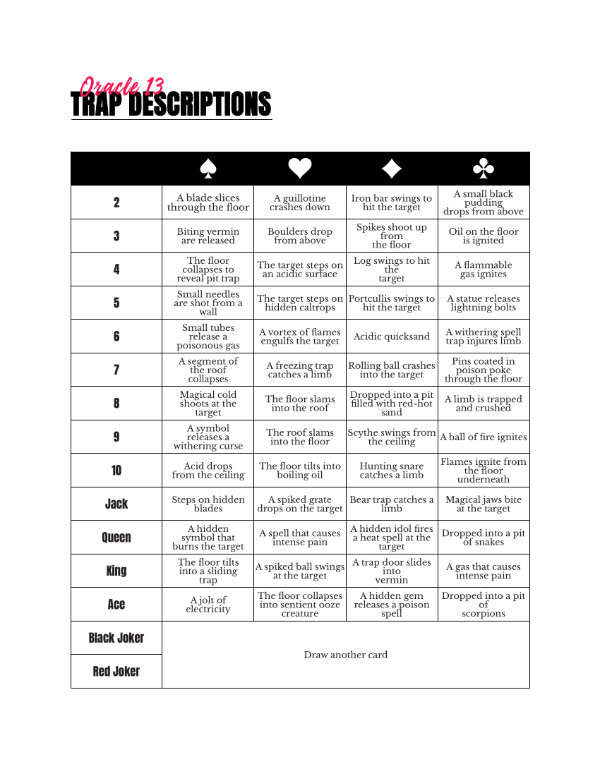
Every time a player character moves inside the room, roll a d100 to see if a trap is triggered. The higher the Rank of your dungeon the higher the probability it will trigger and damage the party. The trigger chance of a trap according to dungeon rank is as follows: Common 20%, Uncommon 40%, Rare 60%, Epic 80%. Traps deal the target’s level + 1d6 damage.
To detect and disable the trap, roll a skill check. In D&D 5e this is a Perception check. Other systems such as the various OSR rulesets should use their respective rules. Our system treats detecting and disabling a trap as having the same in-game effect. It prevents party members from triggering the trap.
Sometimes you will encounter trapped treasures. To obtain the treasure, the trap has to be disabled first. These trapped treasures should be appropriate for your level.
Step 6: Loot treasure
Loot unguarded treasure. Unguarded treasures are level-appropriate treasures that aren’t guarded by monsters or traps. A treasure hoard on the other hand is awarded by special encounters or meeting a dungeon objective. For example, you can award yourself a treasure hoard if the dungeon’s Objective was to look and find a treasure. Use this site to determine what treasure you receive.
Step 7: Roleplay special encounters
Interact with special encounters. Special encounters are roleplaying events that take place in dungeons. They may turn into combat encounters but not necessarily. For examples of special encounters use Oracle: 14: Special Encounters in the Solo Gaming Tool.
Traveling and exploring wilderness areas with the Dungeon Generator
Traveling and exploring wilderness areas is also part of the Dungeon Generator and uses the same rules as dungeon exploration. However, there are no room tiles or traps, and the battle maps are larger with more terrain features.
Whenever you need to travel through a wilderness area to reach a destination or objective, treat it as a type of dungeon exploration. Start by determining the Rank of the Wilderness location by rolling a d4. Fill in the Description, Objective, and Enemies on the Dungeon/Wilderness Worksheet.
How to explore a wilderness area with the Dungeon Generator.
Step 1: Determine the terrain features of the wilderness area
Because wilderness areas don’t have rooms, room tiles won’t work. To create a wilderness area we place or draw terrain features to visualize the area. Roll a d100 and consult Oracle 12: Battlemap Features. Use the Wilderness Terrain table to place the battlemap features.
Place your character on the battlemap. Move your character according to the movement rules of the system you’re using.
Step 2: Determine if there are any encounters.
To determine the encounters in your location, roll a d100 and consult Oracle 11: Dungeon and Wilderness Content. This will tell you whether you face any enemies or encounter other problems.
Step 3: Fight or evade any enemies you come across
If Oracle 11 gives you a combat encounter, roll a d100 and consult the Enemies table on the Dungeon/Wilderness Worksheet. Place the enemies on the opposite side of the battlemap.
Step 4: Evade environmental hazards
Environmental hazards serve the same function as traps. They impede and endanger the party. Environmental hazards include natural occurrences such as sandstorms, quicksand, rock slides, earthquakes, etc. The likelihood the hazard will injure a party member is determined by the Rank of the wilderness area. The injury likelihood for the wilderness area is as follows: Common 20%, Uncommon 40%, Rare 60%, Epic 80%.
To evade an environmental hazard you need to make a Survival check. Failing a check results in damage equal to the target’s level + 1d6.
Step 5: Interact with NPCs
If you come across any friendly or neutral NPCs, you can choose to interact with them. Consult Oracles 4 to 6 to create these NPCs if you want to turn them into more fleshed-out characters.
Step 6: Roleplay special encounters
Special encounters provide roleplaying opportunities in your travels. These may turn into combat encounters depending on the inclinations of the player. For examples of special encounters, you can use the same tool you used for Step 7 previously.
Exploration objectives and the Dungeon Generator
The Dungeon Generator uses Progress to determine when you reach your objective. When you reach the edge of the battlemap start again at Step 1 to create a new area. For every room or wilderness area, you explore, tick a Progress box on the Dungeon/Wilderness Worksheet according to the Rank of the location. Tick 4 Progress boxes for Common, 3 for Uncommon, 2 for Rare, and 1 for Epic dungeons/wilderness areas. Progress shows how close you are to achieving the objective on your Dungeon/Wilderness Worksheet.
Every 8 Progress points add +1 to a Resolution Roll. If you’ve accumulated 8 Progress it’s a +1 modifier, 16 Progress is +2, 24 Progress is +3, and so on. When you think you’ve explored a dungeon or wilderness location sufficiently, roll a 1d6, add the modifiers, and consult the table below.
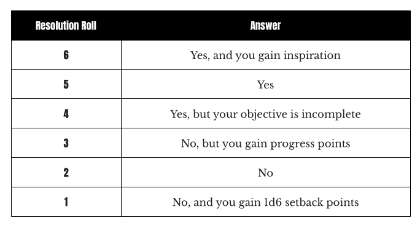
A result of “6” indicates that not only have you reached your objective, but you also gain a point of inspiration. Due to the challenging nature of our solo roleplaying system, we strongly recommend using the inspiration system in 5e. Even if you use other D&D variants, inspiration is very useful for a solo player. Having advantage on a roll at the right moment can save a game, which is why many tabletop RPGs use similar mechanics. You can ignore setback points for dungeons and wilderness areas.

